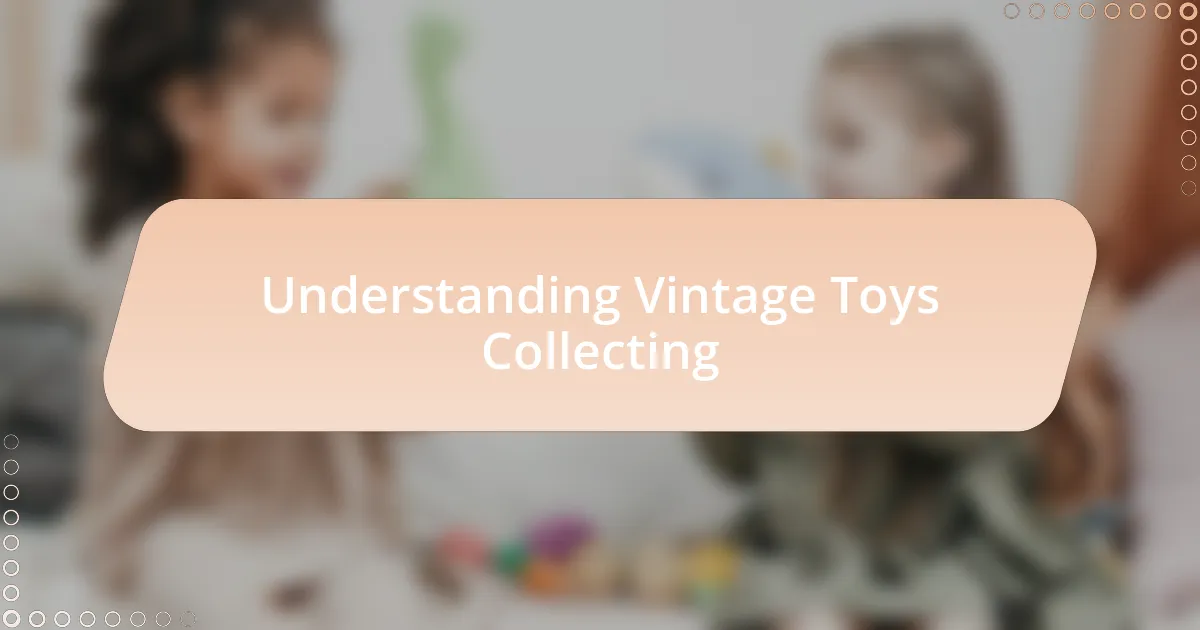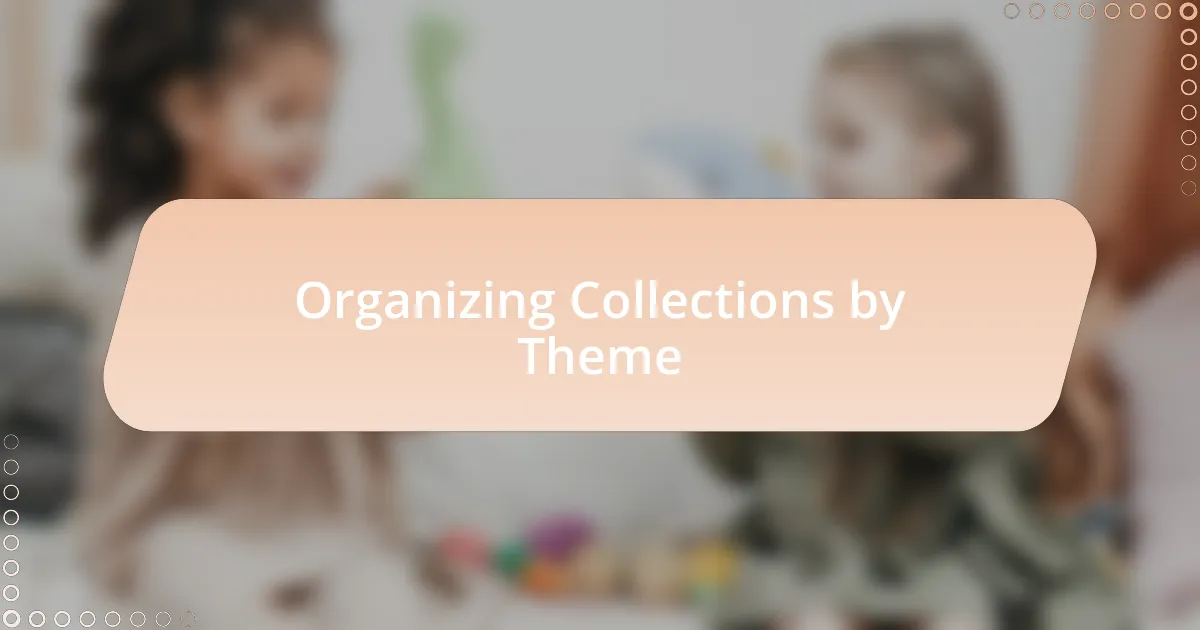Key takeaways:
- Collecting vintage toys connects nostalgia with historical significance, reinforcing the joy and stories behind each item.
- Thoughtful display enhances the visual appeal of collectibles and can spark conversations and connections with others.
- Organizing collections by theme adds cohesion and storytelling, transforming displays into immersive experiences.
- Personal touches in display style create a unique narrative, inviting shared memories and conversations among visitors.

Understanding Vintage Toys Collecting
Collecting vintage toys is a journey that often begins in our childhood memories, where these toys were more than just playthings; they were companions. I still remember the rush of unearthing a forgotten toy from my past at a flea market. Every piece tells a story—not just of its origin, but of the joy it brought during simpler times.
However, the world of vintage toy collecting goes deeper than nostalgia. It’s about understanding the historical context behind each item. For example, did you know that many toys reflect the cultural and technological advancements of their time? This connection adds layers of appreciation to our collections, making each piece not just an object but a piece of history.
As I immerse myself in this hobby, I often find myself pondering: what is it about these toys that captivates so many collectors? Perhaps it’s the thrill of the hunt or the desire to preserve a slice of happiness from our youth. Whatever it is, that passion fuels my collection and the connections I build within this vibrant community.

Importance of Displaying Collectibles
Displaying collectibles thoughtfully can transform a collection from mere objects into a visually captivating narrative. I remember when I finally arranged my vintage toy action figures on a dedicated shelf; it felt like bringing a piece of my childhood back to life. Seeing them lined up, each with its unique pose and personality, truly highlighted their charm and appealed to anyone who shared a similar love for these nostalgic treasures.
Moreover, showcasing your collectibles not only enhances their aesthetic appeal but also sparks conversations. I once had a friend visit who was captivated by my display of classic board games. Our discussion quickly turned into a nostalgic sharing of stories about memorable game nights. These moments remind me of how displaying my collection can forge connections and deepen friendships, rooted in shared experiences and interests.
Lastly, the act of displaying collectibles gives me a sense of pride and accomplishment. Every time I pass by my collection, I’m reminded of the effort and passion I put into curating it. Isn’t it rewarding to create a space that reflects your journey as a collector, where each item represents not just a purchase but a cherished memory waiting to be revisited?

Choosing Display Spaces in Home
Finding the right display space for your collectibles can significantly enhance their visual impact. I once converted an unused corner of my living room into a vibrant display nook, and it became an instant focal point. It’s interesting how a simple choice in location can breathe life into a collection, making it stand out rather than fade into the background.
When selecting display areas, consider not only visibility but also accessibility. I’ve learned that shelving in a high-traffic area allows friends and family to admire my vintage toys without me having to guide them over. Have you ever noticed how certain spaces invite conversation? Those are the spots where your collectibles can truly shine, becoming part of the home’s daily rhythm.
Lighting is another crucial factor that I often reflect on when arranging my collection. A well-lit shelf showcasing my vintage cars near a window turns those metal toys into gleaming showpieces. I find it fascinating how a little creativity can transform a dull spot into a captivating one, don’t you? I always encourage collectors to think about how light interacts with their displays; it can dramatically elevate the overall appeal of the collection.

Display Techniques for Vintage Toys
To truly showcase vintage toys, I’ve discovered that varying the heights of displays can create an engaging visual experience. For instance, when I set up my action figure collection, I used stackable boxes and wall-mounted shelves at different levels. This not only draws the eye but also encourages a closer look, inviting guests to engage with each piece in a more intimate way.
Another technique I’ve enjoyed is grouping collectibles by theme or color. When I arranged my collection of vintage dolls by their original packaging colors, it created a striking visual harmony that caught the attention of everyone who entered the room. I often ponder how certain combinations just feel right and can evoke nostalgia in a way that sparks conversations and memories.
I’ve also experimented with using shadow boxes for some of my most delicate toys. I remember the joy of encasing my tiny robot figures in a shadow box, complete with a backdrop that mirrored the time period they represent. This not only protects them but also gives them a stage to tell their story. Have you considered how much personality can be conveyed through display techniques? Each choice invites your visitors to step into a world shaped by those cherished memories.

Organizing Collections by Theme
When organizing my collections by theme, I’ve found it to be incredibly rewarding and fun. For instance, I have a section devoted to toys from the 80s, complete with figures, games, and memorabilia. It’s amazing how grouping these items together not only reinforces their nostalgic value but also tells a cohesive story that sparks joy and memories when I walk by.
I remember first setting up my collection of superhero toys by their comic book eras. This thematic arrangement transformed the whole display; each toy seemed to echo the culture of its time, creating a dynamic scene. This approach invites viewers to immerse themselves into the world of vintage comic history, offering an unexpected journey through the evolution of the characters we grew up loving. Have you ever noticed how certain themes just seem to resonate more deeply?
Sometimes, I like to get creative and incorporate unconventional themes, like ‘toys that promote friendship’—think charming plush figures and board games. This playful arrangement not only stood out visually but also sparked conversations among my friends and family, reminding us of the bonds forged through play. When I see them pointing and reminiscing over a game they cherished, it’s a delightful reminder of the unique connections these toys bring into our lives. Isn’t it fascinating how a simple display choice can bridge past and present?

Personalizing Your Display Style
Personalizing your display style is an opportunity to showcase who you are as a collector and what your treasures mean to you. I’ve found that incorporating elements like color schemes or display materials can elevate the entire look of my collection. For instance, when I decided to use reclaimed wood shelves, it not only added a rustic charm but also sparked conversations about sustainability and design among my guests.
One of my favorite ways to personalize my display is through lighting. I once added soft, warm lights around my vintage toy shelf, and the transformation was fantastic. The ambiance it created turned an ordinary collection into a captivating showcase that invited viewers in. Have you ever considered how the right lighting can evoke certain emotions tied to your items? It makes a world of difference.
I also love adding personal touches like framed photos of me enjoying those toys as a kid. This simple act not only makes the display more unique but also weaves a narrative into the decor. Visitors often stop and share their own memories, creating a shared space of nostalgia and joy. Isn’t it incredible how our personal stories can turn a display into a conversation starter?

Maintenance Tips for Collectible Displays
When it comes to maintaining my collectible displays, I focus on dusting them regularly to keep everything looking pristine. I remember one time I neglected this task for a few weeks, and when I finally got around to it, I was shocked at how much dust had accumulated. It really emphasized to me the importance of a routine; a microfiber cloth and gentle cleaner can do wonders without scratching the surfaces.
Temperature and humidity play crucial roles too. I once had a vintage toy damaged due to a humid environment, which was a harsh lesson for me. Since then, I pay close attention to where I place my displays, often using a hygrometer to ensure the conditions are just right for preserving the integrity of my collections. Have you ever checked the air around your collectibles?
I find that labeling items adds an extra layer of care, too. Each time I label a piece, I can’t help but recall the backstory associated with it—like the time I found a rare action figure at a flea market, or the thrill of scoring an item from a childhood friend. When labels include dates or seller information, it not only preserves its history but encourages deeper appreciation for the collection as a whole. Isn’t it fascinating how a simple label can spark a flood of memories?